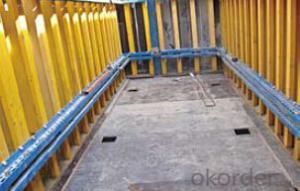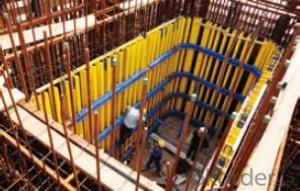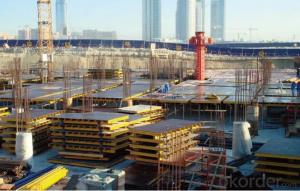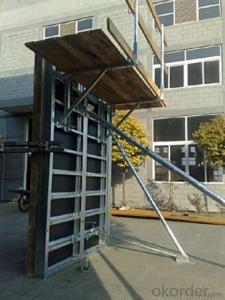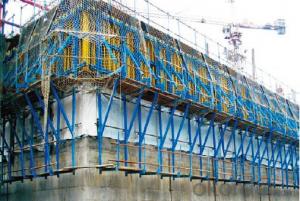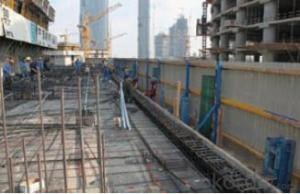Shaft Platform S40 Systems for Formwork and Scaffolding
- Loading Port:
- Tianjin
- Payment Terms:
- TT OR LC
- Min Order Qty:
- 50 m²
- Supply Capability:
- 1000 m²/month
OKorder Service Pledge
Quality Product, Order Online Tracking, Timely Delivery
OKorder Financial Service
Credit Rating, Credit Services, Credit Purchasing
You Might Also Like
Shaft Platform
As operating platform, the shaft platform is mainly used in the concrete pouring of elevator shaft,
equipment shaft, stair shaft of high-rise building and so on.
Characteristics:
◆ The length of shaft beam is adjustable.
◆ Flexible structure makes lifting easier.
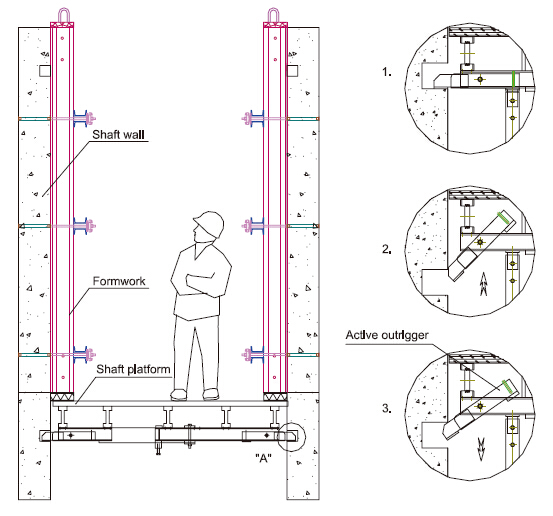
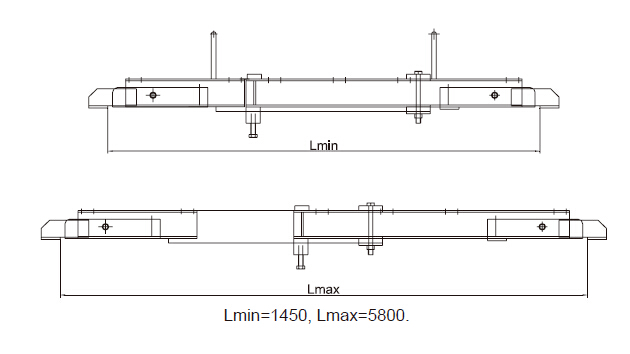
- Q: Can steel formwork be used for both horizontal and vertical concrete placements?
- Indeed, both horizontal and vertical concrete placements can utilize steel formwork. The utilization of steel formwork offers a robust and sturdy framework, rendering it appropriate for a wide range of concrete placements. Its durability and stability enable it to endure the force exerted by the moist concrete, guaranteeing the preservation of its shape and structure throughout the curing phase. Steel formwork exhibits versatility, enabling convenient customization and assembly to fulfill the precise demands of horizontal and vertical concrete placements. Regardless of whether it pertains to the construction of slabs, walls, columns, or beams, steel formwork serves as a dependable and effective solution for generating superior concrete structures.
- Q: What are the different accessories and attachments available for steel formwork?
- There are several accessories and attachments available for steel formwork that enhance its functionality and efficiency in construction projects. Some of the commonly used accessories and attachments include: 1. Wedges and pins: These are used to secure the formwork panels together and create a tight fit. Wedges are inserted into slots on the formwork panels, while pins are used to lock the wedges in place. 2. Formwork clamps: These clamps are used to hold the formwork panels firmly in position, preventing any movement during the concrete pouring process. They ensure that the formwork structure remains stable and secure. 3. Formwork ties: These are used to connect the formwork panels vertically, providing additional strength and stability to the entire structure. Ties are typically made of steel or plastic and are available in various lengths to accommodate different formwork heights. 4. Formwork braces: Braces are used to support and reinforce the formwork system, preventing it from buckling or collapsing under the weight of the concrete. They are typically adjustable in length and can be easily installed and removed as needed. 5. Formwork corners and angles: These accessories are used to create sharp corners and angles in the formwork structure. They ensure that the concrete is poured accurately and that the final structure has the desired shape and dimensions. 6. Formwork spacers: Spacers are used to maintain a consistent gap between the formwork and the reinforcement steel, ensuring proper concrete cover and preventing any contact between the two. They come in various sizes and can be easily positioned and adjusted. 7. Formwork release agents: These agents are applied to the formwork surfaces to prevent the concrete from sticking to them. They facilitate easy removal of the formwork after the concrete has cured, reducing the risk of damage to the formwork panels. 8. Formwork handles and lifting devices: These attachments are used to facilitate the transportation and positioning of the formwork panels. Handles provide a secure grip for manual handling, while lifting devices allow for the use of cranes or other machinery to lift and move the formwork. Overall, these accessories and attachments play a crucial role in ensuring the proper installation, stability, and functionality of steel formwork systems. They enhance the efficiency and safety of the construction process, allowing for the creation of high-quality concrete structures.
- Q: Can steel formwork be recycled?
- Indeed, the recycling of steel formwork is entirely possible. Steel, being a material with remarkable recyclability, can be effectively reused for different purposes subsequent to its utilization as formwork. Once the formwork has served its purpose, it can be gathered and dispatched to a recycling facility where it will undergo processing, ultimately transforming into fresh steel products. By recycling steel formwork, not only are natural resources preserved, but energy consumption is also reduced, and the volume of waste sent to landfills is minimized. This environmentally sustainable practice is gaining traction among construction companies and contractors as they strive to foster a circular economy.
- Q: Can steel formwork be used for underground construction projects?
- Yes, steel formwork can be used for underground construction projects. Steel is a durable and strong material that can withstand the pressure and conditions found in underground structures. It provides stability and support during the construction process and can be easily reused or recycled after the project is completed.
- Q: What are the considerations when designing steel formwork for stairs?
- When designing steel formwork for stairs, there are several important considerations to keep in mind. First and foremost, the structural integrity and load-bearing capacity of the formwork must be carefully calculated and designed. Stairs are subjected to significant dynamic loads as people walk up and down, so the formwork needs to be able to support these loads without any deformation or failure. Additionally, the dimensions and shape of the stairs must be accurately determined to ensure a proper fit within the formwork. This includes considering the rise, tread, and overall dimensions of each step, as well as any landings or platforms that may be present. The formwork needs to be designed to accommodate these dimensions while providing a smooth and safe surface for construction. The construction process and ease of installation should also be taken into account. Steel formwork for stairs should be designed in such a way that it can be easily assembled, disassembled, and transported to the construction site. The formwork should also allow for easy access during the construction process, ensuring that workers can safely and efficiently complete the necessary tasks. Durability and longevity are crucial factors when designing steel formwork for stairs. Steel is a strong and durable material, but it is important to consider the potential for corrosion and wear over time. Proper coatings and protective measures should be incorporated into the design to prevent corrosion and ensure the longevity of the formwork. Finally, safety is paramount when designing steel formwork for stairs. The formwork should be designed to provide a secure and stable working platform for construction workers. This may include incorporating handrails, non-slip surfaces, and other safety features to minimize the risk of accidents or falls during construction. In conclusion, when designing steel formwork for stairs, it is important to consider structural integrity, dimensions, ease of installation, durability, and safety. By carefully considering these factors, a well-designed steel formwork system can be created to efficiently and effectively construct stairs in a safe and reliable manner.
- Q: How does steel formwork contribute to the overall constructability of the project?
- Steel formwork is a crucial component in construction projects as it plays a significant role in the overall constructability of a project. Its contribution is multifaceted and can be seen in various aspects of the construction process. Firstly, steel formwork offers excellent strength and durability, making it capable of withstanding the pressure exerted by the weight of concrete during pouring. This strength ensures that the formwork remains intact, enabling the construction of structures with complex shapes and designs. The ability to withstand extreme loads also allows for the use of thicker and heavier concrete, resulting in stronger and more durable structures. Additionally, steel formwork provides a high level of accuracy and precision in shaping concrete structures. Its rigid structure and dimensional stability allow for consistent and uniform concrete placement, ensuring that the final product meets the desired specifications. This accuracy is crucial in achieving the desired aesthetic and functional outcome of the project. Moreover, steel formwork offers versatility and adaptability. It can be easily modified, adjusted, and reused for different projects, making it a cost-effective option. This flexibility is particularly useful in situations where changes or modifications need to be made during the construction process. The ability to quickly adapt the formwork saves time, reduces material wastage, and enhances overall project efficiency. Furthermore, steel formwork contributes to the overall constructability of the project by improving construction speed. Due to its strength and stability, steel formwork allows for faster concrete pouring and setting times. This expedited construction process reduces project timelines, leading to cost savings and increased productivity. Another important contribution of steel formwork is its enhanced safety features. Steel formwork systems are designed with safety in mind, incorporating features such as handrails, access platforms, and non-slip surfaces. These features provide a safe working environment for construction workers, reducing the risk of accidents and injuries. In summary, steel formwork significantly contributes to the overall constructability of a project through its strength, accuracy, versatility, speed, and safety features. Its ability to withstand extreme loads, provide precise shaping, adapt to changes, expedite construction, and enhance safety make it an invaluable component in construction projects.
- Q: Can steel formwork be used for architectural concrete beams?
- Yes, steel formwork can be used for architectural concrete beams. Steel formwork offers several advantages over traditional wooden formwork, such as increased durability and reusability. Steel formwork is stronger and more rigid, allowing for precise and accurate construction of architectural concrete beams. It also provides a smooth and consistent surface finish, which is important for achieving the desired aesthetic appearance of the beams. Additionally, steel formwork can be easily assembled, disassembled, and transported, making it a practical choice for architectural concrete beam construction.
- Q: Can steel formwork be used for both interior and exterior concrete elements?
- Yes, steel formwork can be used for both interior and exterior concrete elements. Steel formwork offers high strength, durability, and stability, making it suitable for various applications in construction, including both interior and exterior concrete elements.
- Q: What are the different types of steel formwork ties and connectors?
- There are several different types of steel formwork ties and connectors used in construction projects. These ties and connectors are essential for securing and connecting formwork panels, ensuring the stability and strength of the concrete structure being built. 1. Snap Ties: Snap ties are one of the most commonly used types of formwork ties. They consist of two parts - a metal rod and a flat metal plate. The rod is inserted through the formwork panels and then snapped onto the plate, holding the panels securely in place. 2. Wedge Ties: Wedge ties are another popular formwork tie option. They consist of a metal rod with a wedge-shaped end and a flat metal plate. The rod is inserted through the formwork panels, and the wedge is driven into a slot on the rod, creating a tight connection between the panels. 3. Loop Ties: Loop ties are commonly used in situations where the formwork panels need to be easily adjustable or repositioned. They consist of a metal rod with a loop at one end and a flat metal plate at the other. The loop is inserted through the formwork panels, and the rod is bent to secure the panels together. 4. Flat Ties: Flat ties are similar to snap ties but do not have a snap mechanism. They are made of a flat metal plate with holes for inserting a metal rod. The rod is inserted through the formwork panels, and the flat tie is secured by twisting the rod or using a locking device. 5. Tie Rods: Tie rods are used in conjunction with various formwork ties to provide additional strength and stability. They are long steel rods that are inserted through the formwork panels and secured with nuts and washers on both ends. 6. Formwork Clamps: Formwork clamps are connectors used to join and align formwork panels. They are typically made of steel and have adjustable screws or bolts to tighten and secure the panels together. 7. Combi Nuts: Combi nuts are used in combination with tie rods and formwork clamps to connect and tighten formwork panels. They have a threaded hole that allows the tie rod to pass through and secure the panels. These are some of the common types of steel formwork ties and connectors used in construction projects. The selection of the appropriate type depends on factors such as the formwork system being used, the load requirements, and the specific needs of the project.
- Q: How does steel formwork handle concrete pouring in cold weather?
- Steel formwork is a popular choice for concrete pouring in cold weather due to its excellent stability and durability. Cold weather conditions can pose challenges during concrete pouring, such as the risk of freezing, slower curing, and reduced strength development. However, steel formwork effectively handles these issues and ensures a successful concrete pour. Firstly, steel formwork provides a strong and rigid structure that can withstand the external pressure exerted by the concrete. This stability prevents any deformation or collapse of the formwork, which is crucial for ensuring the integrity of the concrete structure. Secondly, steel formwork acts as a thermal barrier, protecting the concrete from the cold temperatures. The steel material has lower thermal conductivity compared to other formwork materials like wood or plywood. As a result, it helps to retain the heat generated during the hydration process of concrete, allowing it to cure properly even in cold weather. Additionally, steel formwork can be easily insulated to further enhance its ability to handle concrete pouring in cold weather. Insulation materials like foam panels or blankets can be attached to the steel formwork, providing an additional layer of protection against the cold temperatures. This insulation helps to maintain the required temperature for proper concrete curing, preventing any potential freezing or delays in the setting process. Lastly, steel formwork enables efficient heating methods to be implemented during concrete pouring in cold weather. Electrical heating systems or radiant heaters can be used to warm the steel formwork, maintaining the desired temperature for the concrete. This ensures that the concrete cures at the appropriate rate, leading to adequate strength development and minimizing any negative effects of the cold weather. In conclusion, steel formwork is well-suited to handle concrete pouring in cold weather conditions. Its stability, thermal properties, and insulation capabilities make it a reliable choice for maintaining the required temperature and ensuring successful concrete curing in colder temperatures.
Send your message to us
Shaft Platform S40 Systems for Formwork and Scaffolding
- Loading Port:
- Tianjin
- Payment Terms:
- TT OR LC
- Min Order Qty:
- 50 m²
- Supply Capability:
- 1000 m²/month
OKorder Service Pledge
Quality Product, Order Online Tracking, Timely Delivery
OKorder Financial Service
Credit Rating, Credit Services, Credit Purchasing
Similar products
Hot products
Hot Searches
Related keywords
